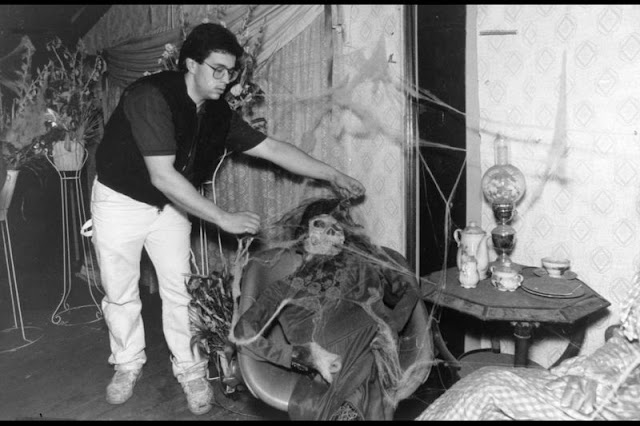After exhaustive research, including old Chicago telephone books, I have verified Sally's Bar-B-Q Restaurants' dates and address history.
"Sally's Bar-B-Q Restaurant" opened about 1935 at 3541 West Ogden Avenue in Chicago (Telephone: ROckwell 2-0716). While on Ogden Avenue, they actually bottled and sold their "Alabama Kum-Back Sauce" in the 1930s and 40s.
 |
| Sally (right) with her husband Benny and her sister Irene (left). Irene worked as a hostess and cashier. Their brother Harry (not pictured) managed the kitchen. |
Sally's opened their second restaurant and named it "The Original Sally's Bar-B-Q" in 1954 at 6445 North Western Avenue, Chicago (Telephone: AMbassador 2-8800). When it was razed, the Devon Bank built on the property.
Sally's on Western moved south of Devon Avenue to 6335 North Western Avenue in 1966, in the building that was next to the Town Pump Restaurant & Nightclub at 6345 North Western Avenue in the 1940s and 50s. Validated.
Their baby back ribs were hickory, smoked over charcoal, and covered with Sally's "Alabama Kum-Back Sauce." The sauce was SO secret that Sally would mix up the spices in her little office, putting the spices in Ziploc bags (available c.1970), then hand the bags to her brother Harry, who managed the kitchen. When asked, he said even HE didn't know what spices went into the sauce, except for the tomato sauce, vinegar, and molasses. Sadly, Sally took the Bar-B-Q spice recipe to her grave.
The Original Sally's Bar-B-Q restaurant was closed in 1976.
sidebar
The "Devon-North Town State Bank" originally opened at 2345 West Devon Avenue in June of 1945. A new building was constructed and, in 1966, opened at 6445 North Western Avenue, the same address as the first Original Sally's Bar-B-Q Restaurant. The bank rebranded itself as The Devon Bank.
"Sally's Stage" (unrelated to Sally's Bar-B-Q) opened in 1977 at 6335 North Western Avenue by the Bortz brothers, Joe and Mike.
The entertainment featured a stream of comics, dancers, singers, magicians, and even acrobats. Sally's hostesses wore roller skates. The theater pipe organ would emerge from a pit below the stage, and the organist would lead a singalong to words posted on a drop-down screen or accompany a silent movie. The waitresses would hop onstage to sing. One night a week was amateur night when anyone with a semblance of talent—even if that talent existed only in the mind of the performer—could take the stage.
Sally's Stage opened a second location in Lombard, Illinois, in 1979. The Lombard location became Blue Suede Shoes in 1983 and was sold in 1986.
 |
| Sally's Stage Full Slab of Baby Back Rib Dinner. |
Sally's Stage was closed in 1993.
sidebar
Personally, the Original Sally's Bar-B-Q had the best BBQ sauce... EVER, in my opinion, and other people agree. The Babyback Ribs were prepared 'old school' where you had to bite the meat off the rib. Many attempts to reproduce Sally's "Alabama Kum-Back Sauce" recipe have come up short.Please leave a comment below about your experience with either the Original Sally's Bar-B-Q, Sally's Stage, or both.
Copyright © 2020 Dr. Neil Gale, Ph.D. All rights reserved.
























